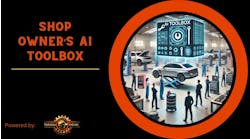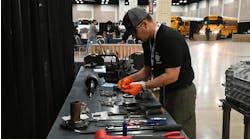Do you have real visibility and control of your operation?
For me, success in fleet maintenance has come from MBWA – management by wandering around, and not WA – walking away. I call MBWA a real-world MBA (Master of Business Administration). I started working toward my MBWA as a young boy working on a farm for John Peck, a boss who was about 10 years older than me. He was my brow-beating tutor and coach.
Teaching both Peck and I was the owner of the company that owned the farm, Demetrios Haseotes. He had built a convenience store chain that today has grown to into the Cumberland Gulf Group. It is an amalgamation of Cumberland Farms, the eighth largest independent convenience store operator by units in the U.S., and Gulf Oil Limited Partnership, one of the largest wholesalers of refined petroleum products in the Northeast and Mid-Atlantic. In 2013, the privately held, family-owned and managed company Cumberland Group generated roughly $17 billion of sales through a footprint of 1,570 locations.
Both Peck and Haseotes taught me many things on a minute-to-minute basis. I quickly learned by their sharing their experiences and successes, as well as through my own failures.
What I didn’t understand was why Haseotes, at the time the CEO of a then 500 million dollar business, was always around checking on things, even showing up on Sunday mornings at 5 a.m. One day I asked him: “Why don’t you leave me alone and let me to my job?” What I really meant was: “I don’t need anyone looking over my shoulders.”
IT IS THE PEOPLE
I was taken aback by his clear answer. Haseotes told me it was his to responsibility to watch his workers, keep them focused on their tasks and their responsibilities and help guide them to excel.
“Your success is my success,” he added. “A business is about its people. Don’t ever forget that.”
Often told to me by Peck, Haseotes and my other mentors over the years is that to be successful you have to start early (the early bird catches the worm), work late, think 24 hours a day and always be around. Show up when you aren’t supposed to and observe everything around you. Make the time to talk with your people, listen to them and absorb what they know.
Stay hungry for knowledge and then share what you have learned with your people. You will only be as successful as the success from the sum of your people.
Learn and develop motivational ways to mentor. Inject your wisdom in a way that will be taken by others, both young and old, Haseotes advised me. Do this in ways that make your employees want to give back, develop loyalty, become solders of the cause to fight for the company’s success and become leaders. That is what MBWA is really all about: a method to exchange knowledge.
As we get seasoned, we gain wisdom to use going forward, but we should also use this knowledge help create the future by sprinkling mental opportunity – the birth of wisdom and experience – on the young and new employees.
Simply put, MBWA is getting immersed in your own business world, dumpster diving, touring, looking, observing, greeting people, chatting with them, etc. We all get so involved with the day-to-day manusha – emails, texts, meetings, Linkedin, Facebook, spreadsheets, budgets, charts, Six Sigma and on and on, that we forget the people. If we are connected with our managers, and our managers are connected with their people, some of the redundant emails, texts and meetings can be reduced, problems can be solved and opportunities can be uncovered.
UNDERCOVER BOSS
Over the past several years, the television show Undercover Boss has grown in popularity. In this program, corporate executives work undercover in their own companies to personally examine their organization's operations with regard to such things how hard their people work, their daily struggles, working environments and condition and how managers don’t or can’t manage. Typically, the bosses are shocked to see what goes on.
Then, the first-line leadership sits around a conference table, most with their heads down, when the facts of what has been going on come to the surface after one week of undercover activity by the boss.
My question is: What have these managers been doing? They are responsible for their team members. As I noted previously, companies are the sum of their people.
After their stint undercover, the company executives return to their true identify and have the employees interacted with invited in for a meeting. The “good” employees are rewarded with a promotion or financial rewards. The “poor” employees are given training or better working conditions.
Leaders should be ashamed that they had to find out what their team members are doing by going undercover.
While a company’s leadership doesn’t need to go undercover, they should get out from behind the desk and wander around, observing and visiting the people who make their business work. Uncover yourself. Become visible.
KEY THINGS TO LOOK FOR
From my many years of experience with fleet maintenance MBWA, I have found there are certain things to be on the lookout for that can hurt your operation’s bottom line. These things are right in front of you and can be discovered if you are wandering around observing things. Here are three key areas to focus on.
Mechanical Items
1. Air filters in the trash bins that have been discarded with 75 percent life remaining.
2. Brake chambers with broken push rods that are misaligned or over stroked.
3. Brake camshafts that are bone dry from lack of grease.
4. Tires that are worn from no or improper alignments and/or low inflation pressures.
5. Slack adjusters in the steel dumpster that are still within their warranty period.
6. Water leaking underneath vehicles.
7. Cores in trash bins.
8. Wheel bearings that have been changed unnecessarily.
9. Brake shoes with 50 percent lining on them or covered in grease from leaky wheel seals.
10. Brake drums that have been removed with remaining life.
11. Bench grinders that have missing components and safety devices.
12. Light cords that are frayed and unsafe.
13. Broken, unsafe and unsecured ladders.
14. Shop lights that are not working properly.
15. Broken springs from loose U-bolts.
16. Cluttered work benches and jawless vices.
17. Rusty wheels and marginal coatings on refurbished rims.
18. Filter crushing area that looks like an oil drilling rig.
19. Overflowing trash bins.
20. Broken tools and shop equipment.
Personnel
1. An unhappy employee who exhibits negative feelings.
2. An employee who complains about a fellow worker.
3. An employee having family issues.
4. Employees extending breaks and lunch periods.
5. Bulletin boards with outdated material.
6. A supervisor that is stressed out and verbally acting in a negative manner.
7. Time cards that show numerous punches, plus late starts and early leaves.
8. A lunch room that is filthy with a microwave and refrigerator that are disgusting.
9. PM sheets that are partially filled out and procedures not being followed.
10. Employee comments about company policies and procedures.
Parts Room (This is where 50 percent of the costs come from.)
1. Shelves are in disarray.
2. Parts all over the floor.
3. Overstock nuts and bolts bins.
4. Many half full spray canisters of paint, WD-40, degreasers, chemicals, etc.
5. Overabundance of starters and alternators in the core bin.
6. Numerous batteries with corroded battery studs.
7. Half torn apart kingpin kits.
8. Overstocked wire terminals and accessory bins.
9. Inadequate supply of fuel and oil filters.
10. Incomplete parts paperwork.
11. Parts that have been expressed shipped that sit unopened.
12. Special order parts shelves with parts that have been there for months.
13. Overstocked brass pins.
14. Tires stored in the racks for months.
15. Way too many tires.
16. Abundant cases of different types and brands of the same motor oil.
17. Obsolete parts everywhere.
18. Dust a foot thick.
19. Non-compliant parts in compliant labeled parts areas.
20. Parts manager out to lunch with an unapproved vendor.
Warranty/Tire Adjustment Area (if there is one)
1. Far too many EGR coolers, water pumps, boxes of sensors, wheel seals, fan clutches, etc.
2. Ungreased, dry, melted and/or worn out U-joints.
3. Tags with no information and over the required days-to-file limitations.
4. No organization of tire casings and a large volume of them.
5. Extra-large bottle of Tums.
MBWA can reveal high costs and out-of-control cost that will most likely not be evident with general ledger accounting and may not be caught by those shops that perform periodic audits.
ADDITIONAL BENEFITS
Management by wandering around yields a number of additional benefits. Along with allowing managers to keep their fingers on the pulse of their organization, up-close-and-personal management makes you more visible and engaged with employees. Making learning-oriented visits to your organization’s frontlines allows you to observe work and solicit employees’ opinions and suggestions for improvements.
Among other things, this can help with successfully resolving problems because seeing a problem in context improves your understanding of the problem, its negative impact and its causes, long before it hits the cost and budget reports.
Want you and your organization to be more successful? Realize that MBWA is not a distraction or that your time is too valuable to do it.
Get out from behind your desk, wander around, touch and feel what is going on. Chat informally with your people. Ask for their input. Thank them and guide them. Become a coach and mentor for them. Teach them how to get their MBWA degree.
Darry W. Stuart is president and CEO of DWS Fleet Management Services (www.darrystuart.com), an independent “Limited Time Executive” transportation and fleet management business. Established in 1999, he and his team that work with companies to lower operating costs and drive change. Stuart has more than 40 years of expertise in fleet management.



